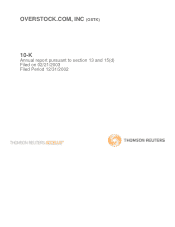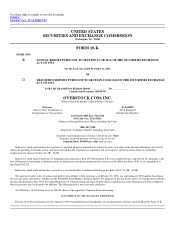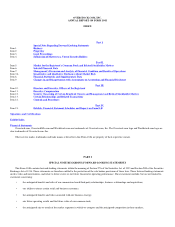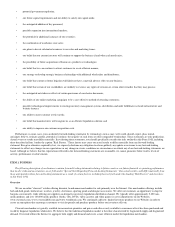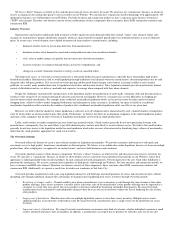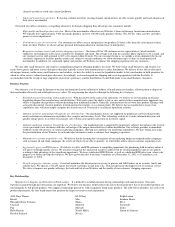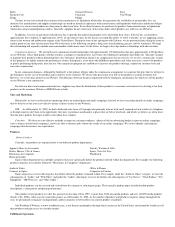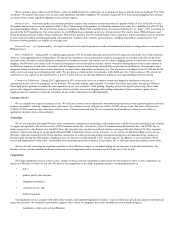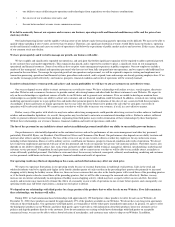Overstock.com 2002 Annual Report Download - page 10
Download and view the complete annual report
Please find page 10 of the 2002 Overstock.com annual report below. You can navigate through the pages in the report by either clicking on the pages listed below, or by using the keyword search tool below to find specific information within the annual report.
Risk Factors
Any investment in our common stock involves a high degree of risk. Investors should consider carefully the risks and uncertainties described below, and
all other information in this Form 10-K and in any reports we file with the SEC after we file this Form 10-K, before deciding whether to purchase or hold our
common stock. Additional risks and uncertainties not currently known to us or that we currently deem immaterial may also become important factors that may
harm our business. The occurrence of any of the following risks could harm our business. The trading price of our common stock could decline due to any of
these risks and uncertainties, and investors may lose part or all of their investment.
Risks Relating to Overstock
Because we have a limited operating history, it is difficult to evaluate our business and future operating results.
We were originally organized in May 1997 and began posting a list of our merchandise on our Website in August 1998. In March 1999, we launched the
first version of our Website through which customers could purchase products. Our limited operating history makes it difficult to evaluate our business and
future operating results.
We have a history of significant losses. If we do not achieve profitability, our financial condition and our stock price could suffer.
We have a history of losses and we may continue to incur operating and net losses for the foreseeable future. We incurred net losses attributable to
common shares of $14.2 million and $11.6 million for the years ended December 31, 2001 and 2002, respectively. As of December 31, 2001, and 2002, our
accumulated deficit was $44.1 million and $55.7 million, respectively. We will need to generate significant revenues to achieve profitability, and we may not
be able to do so. Even if we do achieve profitability, we may not be able to sustain or increase profitability on a quarterly or annual basis in the future. If our
revenues grow more slowly than we anticipate, or if our operating expenses exceed our expectations, our financial results would be severely harmed.
We will continue to incur significant operating expenses and capital expenditures as we:
enhance our distribution and order fulfillment capabilities;
further improve our order processing systems and capabilities;
develop enhanced technologies and features;
expand our customer service capabilities to better serve our customers' needs;
increase our general and administrative functions to support our operations; and
increase our sales and marketing activities, including maintaining existing or entering into new online marketing arrangements requiring upfront
payments.
Because we will incur many of these expenses before we receive any revenues from our efforts, our losses may be greater than the losses we would incur
if we developed our business more slowly. Further, we base our expenses in large part on our operating plans and future revenue projections. Many of our
expenses are fixed in the short term, and we may not be able to quickly reduce spending if our revenues are lower than we project. Therefore, any significant
shortfall in revenues would likely harm our business, operating results and financial condition. In addition, we may find that these efforts are more expensive
than we currently anticipate, which would further increase our losses. Also, the timing of these expenses may contribute to fluctuations in our quarterly
operating results.
Our quarterly operating results are volatile and may adversely affect our stock price.
Our future revenues and operating results are likely to vary significantly from quarter to quarter due to a number of factors, many of which are outside
our control, and any of which could severely harm our business. As a result, we believe that quarterly comparisons of our operating results are not necessarily
meaningful and that you should not rely on the results of one quarter as an indication of our future performance. In addition to the risk factors described in this
report, additional factors that could cause our quarterly operating results to fluctuate include:
increases in the cost of advertising;
our inability to retain existing customers or encourage repeat purchases;
difficulties developing our B2B operations;
the extent to which our existing and future marketing agreements are successful;
price competition that results in lower profit margins or losses;
the amount and timing of operating costs and capital expenditures relating to the expansion of our business operations and infrastructure;
the amount and timing of our purchases of inventory;
our inability to manage distribution operations or provide adequate levels of customer service;
•
•
•
•
•
•
•
•
•
•
•
•
•
•

